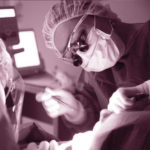Breast surgeon Dr. Valerie Gorman presented at the Annual Meeting of the American Society of Breast Surgeons. Hologic, Inc. (Nasdaq: HOLX) will showcase its growing breast surgery franchise, which includes products such as the new Trident® HD specimen radiography system, LOCalizer ™ wire-free guidance system and the BioZorb ® marker, in Booth #103 at the 20th Annual Meeting of The American Society of Breast Surgeons (ASBS) in Dallas from April 30 to May 5.
The pioneer behind the Genius™ 3D Mammography™ exam, Hologic has recently expanded its product portfolio significantly through insight-driven innovation and strategic acquisitions to address the entire clinical continuum of breast cancer diagnosis and care. From digital specimen radiography and stereotactic breast biopsy systems to breast biopsy markers and surgical guidance systems – Hologic’s comprehensive suite of products is designed to meet the unmet and changing needs of radiologists, pathologists and breast surgeons.
“ASBS marks an exciting milestone this year as we debut our newly expanded portfolio of breast-conserving surgery solutions,” said Pete Valenti, Hologic’s Division President, Breast and Skeletal Health Solutions. “We look forward to building upon our relationships with this community of leading breast surgeons and showcasing our growing suite of products designed to improve cancer detection, patient satisfaction and comfort, and facility workflow.”
Hologic Products
A sampling of the products on display in the Hologic booth includes:
The Trident®HD specimen radiography system, a next-generation solution that delivers enhanced image quality, improved workflow, and instant sample verification during breast-conserving surgeries and stereotactic breast biopsies. 1 The system, which recently received FDA clearance in the U.S. and a CE Mark in Europe, uses amorphous selenium direct capture imaging – the same detector technology used in Hologic’s 3Dimensions™ mammography system – to generate crisp, clear, high-resolution images. The system also features a bigger detector that allows for complete imaging of larger breast surgical specimens, along with a wide range of surgical and biopsy samples. 2
The LOCalizer™wire-free guidance system, which is designed to enable precision and ease of use for breast surgery guidance. The LOCalizer tag is designed to replace traditional wire-guided methods, helping provide increased comfort and convenience for patients and their healthcare teams. Additionally, the Tag is designed to be implanted into the breast any time prior to the surgery, providing increased flexibility for patients and providers. A recent study has shown that the LOCalizer tag may be able to reduce positive margin rates with lumpectomy due to the unique feature of reading distance from the tag. 3
The BioZorb®3D bioabsorbable marker, an implantable three-dimensional marker that potentially enables a more targeted radiation therapy and helps clinicians overcome challenges in breast-conserving surgery or lumpectomy. When used to mark the surgical site, BioZorb has been shown to yield good to excellent cosmetic outcomes for at least two years post-surgery and result in minimal scarring on mammography after breast-conserving surgery. 4,5 Additionally, the marker has been shown to improve accuracy in setup and boost targeting as reported by 96 percent of radiation oncologists. 6
The TruNode®wireless gamma probe, a sterile, single-use device for common, radio-guided surgical procedures that senses hotspots using an innovative detector and heuristic audio feedback technology. The TruNode probe is designed to perform less invasively and may reduce infection risk from reprocessing due to its sterile, single-use performance.
Dr. Gorman’s Presentation on 5-day Radiation Therapy
Hologic will also host a breakfast symposium, BioZorb® and a New Way to 5-day radiation, featuring Cary Kaufman, MD, FACS and Valerie Gorman, MD, FACS on Saturday, May 4 from 6:30 – 7:45 am. Additional hands-on workshops hosted by Hologic will cover topics such as stereotactic breast biopsy, oncoplastic skills, and portable breast ultrasound.
The Genius ™ 3D Mammography ™ exam (also known as the Genius ™ exam) is only available on a Hologic® 3D Mammography™ system. It consists of a 2D and 3D ™ image set, where the 2D image can be either an acquired 2D image or a 2D image generated from the 3D ™ image set. There are more than 6,000 Hologic 3D Mammography ™ systems in use in the U.S. alone, so women have convenient access to the Genius exam. To learn more about the Genius exam, visit http://www.Genius3DNearMe.com.
About Hologic, Inc.
Hologic, Inc. is an innovative medical technology company primarily focused on improving women’s health and well-being through early detection and treatment. For more information on Hologic, visit www.hologic.com.
Hologic, 3D, 3D Mammography, 3Dimensions, BioZorb, Genius, The Science of Sure, Trident and TruNode are trademarks and/or registered trademarks of Hologic, Inc., and/or its subsidiaries in the United States and/or other countries. Hologic is an exclusive distributor and licensee of the LOCalizer product and trademark, which is manufactured by Health Beacons.
Forward-Looking Statements
This news release may contain forward-looking information that involves risks and uncertainties, including statements about the use of Hologic products. There can be no assurance these products will achieve the benefits described herein or that such benefits will be replicated in any particular manner with respect to an individual patient, as the actual effect of the use of the products can only be determined on a case-by-case basis. In addition, there can be no assurance that these products will be commercially successful or achieve any expected level of sales. Hologic expressly disclaims any obligation or undertaking to release publicly any updates or revisions to any such statements presented herein to reflect any change in expectations or any change in events, conditions or circumstances on which any such data or statements are based.
This information is not intended as a product solicitation or promotion where such activities are prohibited. For specific information on what products are available for sale in a particular country, please contact a local Hologic sales representative or write to [email protected].
SOURCE: Hologic, Inc., used by permission.
1 Wilson A. Trident 2.0 QUAL Qualitative Findings. Explore and identify the ideal breast biopsy verification system from the OR. Kadence International. July 2016.
2 Compared to original Trident system
3 N = 50 patient, single arm pilot study. DiNome M et al. Microchipping the breast: an effective new technology for localizing non-palpable breast lesions for surgery. Poster presentation, Society of Surgical Oncology annual meeting, Mar 27-30, 2019.
4 Kaufman, et al. Oncoplastic Surgery with the 3-D Tissue Implant Maintains Post-Lumpectomy Breast Contour. Poster presented at the American Society of Breast Surgeons 18th Annual Meeting, May 2-5, 2018.
5 Kaufman CS, et al. Registry Study of 337 Bio-Absorbable 3-D Implants Marking Lumpectomy Cavity Benefit Cosmesis While Targeting Radiation. Poster presented at the Society of Surgical Oncology Annual Cancer Conference March 15-17, 2017.
6 Harms S, et al. Mammographic imaging after partial breast reconstruction: Impact of a bioabsorbable breast implant. J Clin Oncol 33, 2015 (suppl 28S; abstr 111)
View source version on businesswire.com:https://www.businesswire.com/news/home/20190430005179/en/
 Body image issues are real concerns for women cancer patients that can impact self-esteem and mental health. You may view your body and yourself differently after
Body image issues are real concerns for women cancer patients that can impact self-esteem and mental health. You may view your body and yourself differently after  Chemotherapy is an effective way to
Chemotherapy is an effective way to  When someone gets diagnosed with
When someone gets diagnosed with  Cancer is perhaps the scariest word in the dictionary, capable of striking fear into the heart of anyone who hears it inside of a second. Part of the problem is that the minute a doctor says that word, anything that he or she says subsequently becomes a total blur. It is like the patient is trying to listen to the doctor while being underwater. That’s the reason we have a resource section on our site. This article answers questions about the procedure for a biopsy of the sentinel lymph node.
Cancer is perhaps the scariest word in the dictionary, capable of striking fear into the heart of anyone who hears it inside of a second. Part of the problem is that the minute a doctor says that word, anything that he or she says subsequently becomes a total blur. It is like the patient is trying to listen to the doctor while being underwater. That’s the reason we have a resource section on our site. This article answers questions about the procedure for a biopsy of the sentinel lymph node.
 The public conception of breast cancer treatment is quite positive; people are confident that medical science has achieved a reasonable degree of success at dealing with breast cancer, and so ironically many women express more concern about how their body will look postoperative.
The public conception of breast cancer treatment is quite positive; people are confident that medical science has achieved a reasonable degree of success at dealing with breast cancer, and so ironically many women express more concern about how their body will look postoperative.
 Surgery of any kind always involves some degree of risk, and Breast Cancer surgery is no different in that regard. The good news is that the vast majority of breast cancer surgeries across the world are completed successfully without any complications. Generally speaking, when any complications do arise, they tend to be minor and easy to deal with from a medical standpoint.
Surgery of any kind always involves some degree of risk, and Breast Cancer surgery is no different in that regard. The good news is that the vast majority of breast cancer surgeries across the world are completed successfully without any complications. Generally speaking, when any complications do arise, they tend to be minor and easy to deal with from a medical standpoint.
 Breast Cancer consists of many different types, so if you have been diagnosed with
Breast Cancer consists of many different types, so if you have been diagnosed with  Humans by their very nature do not like the unknown, which might explain why one of the most frequent questions we are asked at the Texas Breast Center is what to expect regarding your lumpectomy surgery recovery.
Humans by their very nature do not like the unknown, which might explain why one of the most frequent questions we are asked at the Texas Breast Center is what to expect regarding your lumpectomy surgery recovery.
 We want to feature a recent study by Rufus Mark, MD, Gail Lebovic, MD, Valerie Gorman, MD, Oscar Calvo, PhD. on recent developments in Breast Cancer Treatment.
We want to feature a recent study by Rufus Mark, MD, Gail Lebovic, MD, Valerie Gorman, MD, Oscar Calvo, PhD. on recent developments in Breast Cancer Treatment.
 Late in 2017, the media picked up on a
Late in 2017, the media picked up on a  New radiation option cuts time by two-thirds
New radiation option cuts time by two-thirds